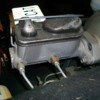quote:
Originally posted by Dave2811:
The E2TA casting number crosses to Dorman #M39388, which is a '83 - '85 Ford Ranger and Bronco II.
Dave its not a Ranger/Bronco master, I know because I've seen Mustang guys make that mistake. If a person buys the replacement master that the E2TA number crosses over to, you'll end up with a cast iron master designed for drum rear brakes.
My Pantera has the same master. If I had to guess, I'd bet it was purchased from Dennis Quella. I know its a Ford master, but I don't know which Ford. Its not in the SVO catalog, so it must have been a production item. I can tell you this.
There are 4 considerations in chooosing a master.
- The oem master has a different mounting flange bolt pattern than the Ford masters (or GM masters). A mounting flange adapter is required between the master and the vacuum booster to adjust for the differences in bolt pattern.
- The oem master had a 23mm piston, which is about 0.900". The oem/aftermarket/retrofit Ford masters come in two piston sizes, 1.000" for use with a brake booster, and 1-1/8" for use without a brake booster.
- It appears the masters designed for 4 wheel disk brakes are a bit different than the masters designed for front disk/rear drum applications. That difference may be the check valves designed to hold back a tiny bit of pressure.
- The last consideration, some masters have ports threaded for SAE tube fittings, others have ports threaded for metric tube fittings. 1979 through 1986 Mustangs had SAE fittings. Beginning 1987 they had metric fittings. Steve's master has brass tube fitting adapters screwed into the ports.
I used to know what application that master was originally designed for, but it slips my mind now. I believe its for a Mustang, either a GT Mustang or an SVO Mustang. One of the hi-performance versions that was equipped with rear disk brakes.
If your car is already equipped with the mounting flange adapter, then its ready for a Ford master. You'll want one with a 1.000" piston (designed for use with a booster) and designed for 4 wheel disk brakes. If you want to keep the same tube fitting arrangement, you'll need to figure out what type of adapters those are. For SAE ports, purchase a master for pre-1987 Mustangs. For metric ports, purchase a master for 1987 or later Mustangs.
You'll find a selection of brake parts at the parts houses that supply parts for rear disk brake conversions. There is a nice looking aftermarket Ford master on the market having plastic reservoirs, it kinda looks like the oem master. Wilwood also has some nice masters available. And of course, oem masters are available from Wilkinson.
-G



